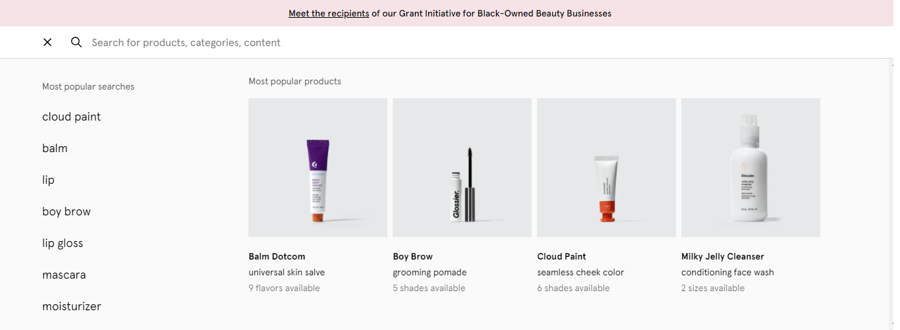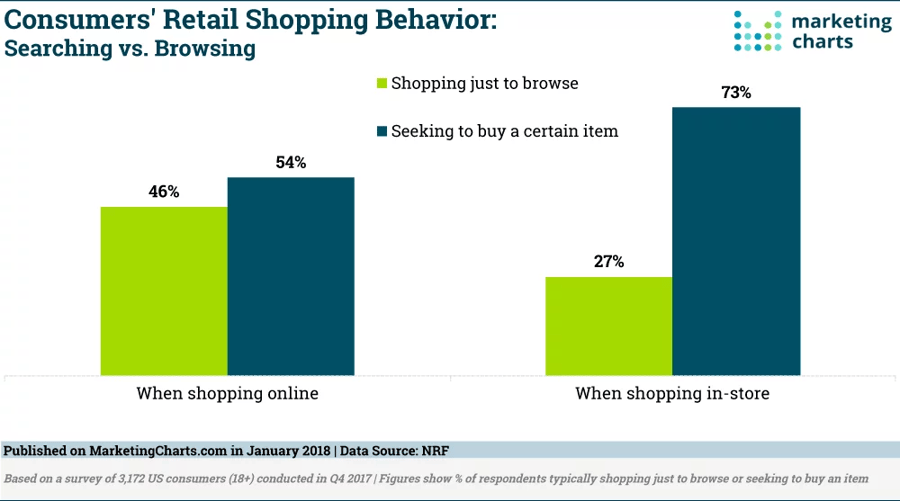
If your products are not easy to find, you’re losing customers in real-time.
According to Marketing Charts, 46% of shoppers say they go shopping online just for browsing.
Almost half of your traffic comes to your website, hoping that you’ll show them the right product for them.
What this means is… Are you optimizing your website for the people who still don’t know what to buy?
Think about the mentality you have when researching products online. Do you recommend the most relevant products? Are you making it easy for your visitors to find all your products? Do you present your products properly?
That’s why eCommerce brands need to embrace product discovery and optimize their websites for it.
So if you’re here to learn about product discovery, keep reading.
What Is Product Discovery for eCommerce Businesses?
Product discovery is the phase in the customer’s journey where the prospect is still researching and browsing for the right product that meets their needs and where the brand guides the prospect towards their products.
Right now, this term has become a tendency in the eCommerce space, and it tries to replicate — or improve — the customer’s experience when shopping in retail stores.
And that’s where successful brands try to optimize.
But different from a physical store, customers can’t touch and try the product when browsing online for products — so you need to try harder to present your products.
See, imagine the buyer's journey for a moment. They may land on one of your product pages from Google, but it turns out that it’s not the product they’re looking for.
Your job here is to let them know that more options exist, so you can improve their shopping experience by recommending similar products for different use cases.
The same happens when they land on your homepage, or your blog, or your landing page.
You should focus on helping them find the right product, whether by recommending more items, improving your page layout, or giving them tools to search for what they need.
So… How can you tell if your website needs to improve product discovery?
Well, start by watching how your visitors react to your website. Do they click on many similar products? Do they explore your category pages? Or they come to your website knowing exactly what they want?
If most of your customers just come and buy/leave before much prior interaction… Your product discovery may be in a poor state.
Think about this: When you’re not optimizing product discovery, you’re losing many potential clients every second.
And the best you can do is take action through some of the strategies we’ll cover right now.
5 Strategies to Optimize Your Website for Product Discovery
There’re many places you’ll need to check when improving your product discovery experience.
What these strategies will cover isn’t more than the best practices you can apply to every factor.
So let’s talk about the five strategies you can follow to optimize your website for product discovery.
1. Ensure Easy Navigation Throughout Your Website

Product discovery is all about making it easier for prospects to find their ideal product.
And the main way to do this is to ensure that your website is clear and intuitive, with a particular focus on keeping a memorable shopping experience.
As a rule — both for user experience and SEO — every page on your site should be reachable within only three clicks.
This ensures that every product can be found in as short as a few seconds.
For this, you can try some few tips:
Give your homepage a purpose
eCommerce homepages must always invite visitors to explore your catalogs and content.
And it becomes more optimal when you start implementing high-quality web design, recommending a personalized list of products, and including user-generated content to create an inspiring visual experience for your prospects.

Source: Venngage
You can consider including current promos, trending products, new items, and even educational content for those looking for some guidance.
Invest in top-notch web design
First impressions play a huge factor in eCommerce brands. And having a clean, visually appealing web design is the main factor in this.
For product discovery, you want to design your site in such a way that presents each product as compelling as possible — not just as a bunch of pictures grouped in a grid format.
Start improving by including high-quality images that resonate with what your customers are looking for, and then you can mess around with the website layout.
Whether you hire web designers or use tools like Designmodo to build a good website. This is an important step you can’t miss.
Flesh out your category pages
It is a common practice among online stores to hide products to improve site speed.
The problem is, this hurts product discovery, and your customers will probably feel frustrated when noticing that there are +100 more pages to browse.
To optimize your category pages, you can try making it more user-friendly and include tools like filters and searchers in a position that incentivizes visitors to use it.
And instead of packing up a bunch of products on the same page, better try to give each product their own focus, so your prospects can see more about them without having to enter the product page.
Include breadcrumbs at the top of the page
Breadcrumbs are a great way to make your customers understand where they are on your site and navigate easily through it.
It gives them the option to return to the catalog page and makes it easier for you to stick to the rule of making each page reachable within three clicks.
This, without saying that it can improve your site’s SEO, making it easier for Google to understand your site structure.
And as for your website in general, consider checking other brands’ websites to compare with yours and get ideas for improvement.
2. Incorporate Product Suggestions

Source: Amazon
Optimal product discovery needs to give your visitors additional, relevant options if they’re not on the right product page.
And this becomes key, especially when there’s a product that’s out of stock but that keeps getting traffic — so you can recommend other products and avoid losing potential clients.
Plus, you can leverage product suggestions to get more upsells and cross-sells in the buying process, which can help you increase your average order value and thus get more revenue per customer.
Some of the things you need to implement for this include:
- Similar products. It’s doubtful that your customers will land on the right product on the first try. Recommending similar products will always be a great way to make it easy to find more of your products.
- “Often bought together.” Here’s when you can invite the customer to include more accessories to their cart by bundling a package that can be used for a specific purpose (think about a “grill package,” or a “music recording starter pack,” or similar).
- Add this product to get free shipping. It is a common practice to offer free shipping for purchases higher than a certain value. What you can do to increase product discovery is to provide free shipping for specific products instead, making the prospect reconsider the product and probably buy it.
- Personalized alternatives. Personalized experiences are always more effective, so if you can add personalized recommendations to your pages, you’ll surely see an increase in sales.
3. Optimize the Search Experience

Some prospects come to your website with an idea of what they’re looking for.
But when your store has way too many products to show, most eCommerce sites must have search bars and filters so your prospects can write down what they’re looking for.
Optimizing your website layout to incentivize its use is something we’ve talked about earlier. When it comes to improving your customer’s search experience, it becomes even more critical as your business grows, and more items are added.
Some things you need to do to ensure a smooth search experience include:
Improved product sorting and filtering
Unsatisfactory searches halt product discovery in ways you can’t imagine.
Sometimes, regardless of how sophisticated your products are, customers are just looking for a color or a simple feature — that’s why it’s so essential to conduct in-depth customer research.
Tailoring your sorting and filtering options according to your target customers will make your product catalog easier to navigate and see more results. So it’s worth giving it some tests if you can.
Avoid the blank results with intelligent guesses
Worse than not finding what you want is to get a blank result because of a typo.
Ensure that your searcher can respond to misspellings and show anything relevant even if the search query has nothing to do with your brand.
The last thing you want your prospects to think about your brand is that it doesn’t offer enough options.
Always recommend similar products
A prospect may not know how to express what they want.
But if you get to recommend a balanced variety of products, you can nail the right product that meets their needs and lead to a sale.
A good practice for this is to show a product comparison table and compare the product with both expensive and cheaper options to evaluate them more easily and make a buying decision.
Personalized search results
Personalization is getting more and more standardized, and studies keep showing that shoppers prefer personalized experiences.
So if you can add more personalization into your internal search algorithm, it would be an excellent product discovery booster.
What’s great about personalization is that each person will have a different set of preferences you can later use to make your automated marketing campaigns stronger.
4. Do the SEO Work
 Studies show that most buyers start researching their products online (mainly from Google).
Studies show that most buyers start researching their products online (mainly from Google).
So the best way to make your products reachable for your target customers is to be there whenever they do a Google search.
Optimizing your product pages for SEO doesn’t have to be hard. Here’s a basic SEO checklist you can use:
- Keyword Research. Find the right keywords with the right search intent for your page. Do not confuse transactional keywords like “blue switch keyboards under $30” and informational keywords like “best PCs for remote work,” as both require different kinds of content formats to meet their search intent.
- Include your target keyword in the right places. Headers, descriptions, alt texts, and making sure that Google knows what your page is about.
- Write an alt text for each image. Algorithms still can’t understand images, so make sure to include a relevant alt text that describes what the image is about.
- Write a compelling meta title and meta description. The ranking will do nothing if you don’t get click-throughs in the SERP, so write exactly what your customers are looking for.
- Truly understand the search intent behind your keywords. Are they actively looking to buy something? Or they’re just doing research? Here’s when doing keyword research properly comes into play, so make sure that your pages show exactly what your target buyer wants to see with each term.
- Insert schema markups, if possible. If your products have ratings, recipe format, and use any useful website gadget. It helps to optimize for schema markups whenever it fits.
5. Measure Your Site Performance

What gets measured gets controlled.
And if you can find ways to measure product discovery within your site, you’ll be able to find straight-forward solutions that will improve your conversions.
All it takes is to watch how your visitors behave on your site.
Take a look at how many pages they visit, how long they stay on each page, and the best-performing pages. I bet it will give you some good ideas about how your business performs.
Some of the metrics you’ll need to look out for can be found in Google Analytics (with few exceptions), and they include:
Bounce rates
A bounce rate that’s too high means that your page is not meeting visitors’ expectations, or worse than that, that your page is a mess, and you need to rework it.
This metric also shows how long visitors stay on site, and it also plays a huge factor for SEO.
So always keep an eye on it, and try to reduce as much as possible.
Site speed
Visitors these days are more impatient than ever, and they’re not willing to wait more than 3 seconds to load your website.
Optimizing your images, animations, and website content for site speed is what you’ll need to do eventually to get the most out of your traffic.
There’re online tools to test your site speed, and they’ll tell you right upfront what the problems are.
So take some time to optimize your site’s speed; your prospect will appreciate it.
Conversion rates
Traffic means nothing if it doesn’t convert into sales.
Everything you do to optimize product discovery, it’s all aimed to maximize conversion rates. That’s why you’ll find most businesses doing tons of A/B tests to make the slightest improvements in sales.
You can do the same and put effort into getting your customer’s experience to the next level. But don’t forget the importance of conversion rates, as they give you a reality check on how well your business is doing.
Customer heatmaps
These are great for understanding how your prospects interact with your pages, see what catches their attention, see what they ignore, and see what’s holding them from moving forward.
If you can use it to improve the shopping experience, it will also work for product discovery.
There’re many tools like Hotjar and CrazyEgg that can help you with this and give you some actionable ideas to improve your conversion rates.
You can also even check Hotjar’s guide to usability testing to know what this is all about.
But in the end, it all comes down to the buyer’s journey back from doing the first search, browsing your website, to finally making a purchase.
And that’s the experience you want to focus on.
Improve the Shopping Experience
The future of eCommerce brands will involve product discovery, so you better start optimizing your website for it.
In this post, you’ve learned some strategies like:
- Improving your website navigation experience.
- Using product suggestions to increase upsells and cross-sells.
- Polishing your internal search and filtering functionalities.
- Doing SEO work.
- Watching out for site performance.
These resources will give you a starting point and give you some strategic ideas. But ideally, you’ll need to conduct in-depth customer research to understand how your customers behave and what their desires are.
So as your next step, start by checking your website for areas of improvements and ensuring that your prospects have a place to browse for products efficiently.






Leave a reply or comment below